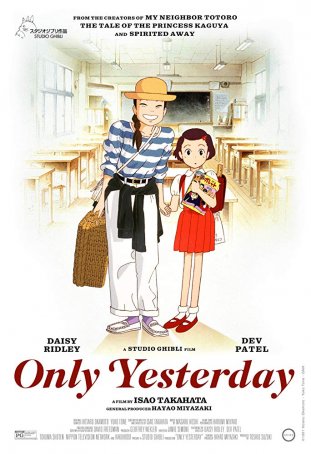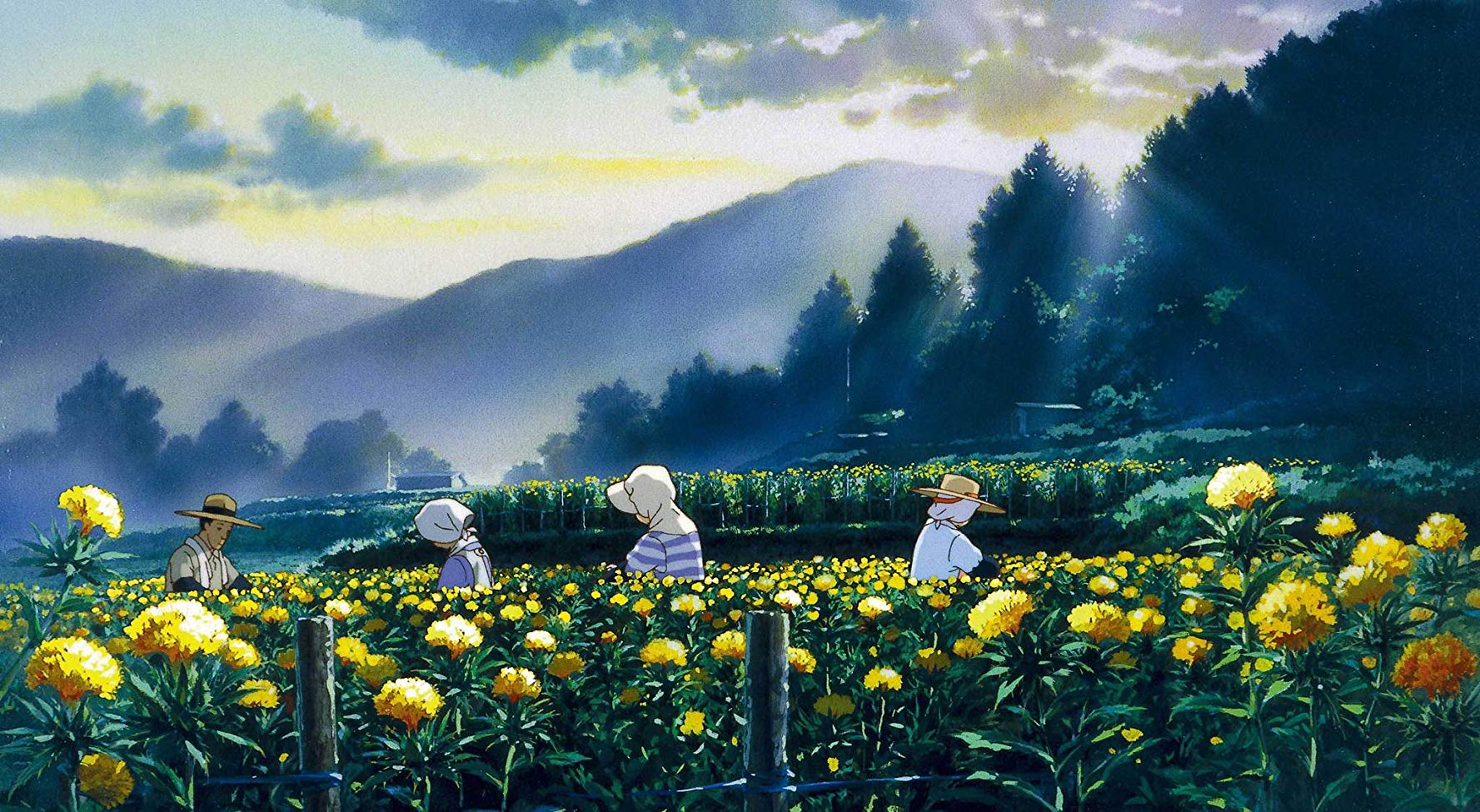Only Yesterday (Japan, 1991)
October 13, 2019
For 25 years, Only Yesterday remained a frustratingly missing entry in Studio Ghibli’s North American collection. The film’s U.S. distribution rights were, like those of the entire animated catalog, held by Disney in the wake of a landmark 1996 deal. However, because of certain “adult” material (referencing menstruation), Disney refused to release the film without edits and Studio Ghibli maintained its “no cuts” policy. Only once Disney ceded distribution rights to GKIDS was Only Yesterday given the treatment it deserved: an English-language dub, a limited theatrical run, and a Blu-Ray home video release. All of this happened in 2016. Interestingly, although Only Yesterday was made in 1991, the timeless quality of the story and animation make it difficult to believe it’s older than many of the actors who leant their voices to the new dub.
Only Yesterday was the first Studio Ghibli collaboration between Japanese animation titans Hiyao Miyazaki and Isao Takahata. In interviews, Miyazaki has downplayed his role in Only Yesterday (he is officially credited as the “production producer”), claiming that his function was purely logistical and that he had no creative input. This was Takahata’s follow-up to 1988’s devastatingly powerful Grave of the Fireflies and represented the fifth Studio Ghibli release (three from Miyazaki, two from Takahata).
 The movie was considered groundbreaking at the time of its
release in that it attempted (with great success) something not previously
considered: making an animated version of a story that would normally be
live-action. It’s neither fantastical nor filled with cute creatures and
talking animals. It’s a straightforward drama targeted primarily at adult women
(although it proved to be gender-neutral in its appeal). Its box office triumph
(Japan’s highest grossing film in 1991) opened the door for other filmmakers to
opt for animation.
The movie was considered groundbreaking at the time of its
release in that it attempted (with great success) something not previously
considered: making an animated version of a story that would normally be
live-action. It’s neither fantastical nor filled with cute creatures and
talking animals. It’s a straightforward drama targeted primarily at adult women
(although it proved to be gender-neutral in its appeal). Its box office triumph
(Japan’s highest grossing film in 1991) opened the door for other filmmakers to
opt for animation.
Only Yesterday is set during two timelines. The primary one occurs in 1982 where the main character, Taeko Okajima (Miki Imai), is a 27-year old office worker living in Tokyo. Throughout the film, Taeko takes memory excursions back to fifth grade when, as an 11-year old (Youko Honna), she struggles with puppy love, the onset of puberty, an early infatuation with theater, and other frustrations and joys of being young in the late 1960s.
 Taeko embarks on a journey to the countryside, where she
stays with distant family and helps with the safflower harvest. She is met at
the train station by Toshio (Toshiro Yanagiba), a cousin to her brother-in-law.
Although she barely recognizes him, he is more cognizant of her and the two
become frequent companions during her stay in Yamagata. At times, her memories
absorb her to the point of abstraction; they make her question her current life
choices and provoke her to take chances she might not otherwise take. Although
the movie “ends” with Takeo boarding a train to Tokyo, the end credits reveal
that she disembarks at the first stop and returns to Yamagata, where she is
reunited with Toshio.
Taeko embarks on a journey to the countryside, where she
stays with distant family and helps with the safflower harvest. She is met at
the train station by Toshio (Toshiro Yanagiba), a cousin to her brother-in-law.
Although she barely recognizes him, he is more cognizant of her and the two
become frequent companions during her stay in Yamagata. At times, her memories
absorb her to the point of abstraction; they make her question her current life
choices and provoke her to take chances she might not otherwise take. Although
the movie “ends” with Takeo boarding a train to Tokyo, the end credits reveal
that she disembarks at the first stop and returns to Yamagata, where she is
reunited with Toshio.
The movie’s strength is the deftness of touch it shows in depicting Taeko’s childhood – tiny vignettes that capture the ups and downs of pre-adolescence – moments so universal in their presentation that they cross generational, cultural, and gender barriers. As a 51-year old white, American man, I have little in common with Takeo, yet I related to her experiences as if they were my own. This represents the genius of Takahata.
The film allows Taeko and Toshio’s romance to develop gradually. As in all love stories, we’re perhaps aware of the mutual attraction before they are. Toshio telegraphs his feelings but Taeko is oblivious until the end. During their time together, there are gestures and expressions (an indication of how much effort was put into the animated character details) that show the developing closeness. Their conversations are often banal (about things like organic farming) but the companionability in the interaction is evident. And, as in many restrained romances of the big screen, no kiss is needed at the end to confirm what we know.
 Only Yesterday
employs the same basic animated style that characterized many of the early
Studio Ghibli films. (A large number of the in-house artists worked with both
Miyazaki and Takahata.) The background is a lush, sometimes impressionistic
painting. Movement is confined to the foreground characters. Only Yesterday’s innovation is to
concentrate on the facial musculature of the adult characters. While the
children resemble “traditional” manga characters, the adults are more
realistic. (In a break from how things were normally done in Japanese animation
of the time, Takahata borrowed the American approach of recording the voices
first then shaping mouth movements to match the words.)
Only Yesterday
employs the same basic animated style that characterized many of the early
Studio Ghibli films. (A large number of the in-house artists worked with both
Miyazaki and Takahata.) The background is a lush, sometimes impressionistic
painting. Movement is confined to the foreground characters. Only Yesterday’s innovation is to
concentrate on the facial musculature of the adult characters. While the
children resemble “traditional” manga characters, the adults are more
realistic. (In a break from how things were normally done in Japanese animation
of the time, Takahata borrowed the American approach of recording the voices
first then shaping mouth movements to match the words.)
The GKIDS home video release provides two options to cater to different preferences, both of which are good enough that it becomes a matter of personal choice. For “purists,” the original Japanese version is available (with English subtitles). The dubbed edition, with Daisy Ridley as Taeko and Dev Patel as Toshio, has the usual awkwardness that results from mismatched lip movements, but is fine for those who prefer not to read subtitles. (For an idea of the differences between the dubbed dialogue and the original Japanese, it can be instructive to watch the English dub with English subtitles turned on.)
For those who know Takahata only for Grave of the Fireflies, Only Yesterday provides a different perspective of the director – one that’s more playful and nostalgic. I have said that, although I consider Grave of the Fireflies to be one of the most moving and potent animated films ever made, it’s too painful to be revisited on a frequent (or even infrequent) basis. Only Yesterday, on the other hand, is as much a pleasure to see on the second or third time as it is on the first.
Only Yesterday (Japan, 1991)
Cast: Miki Imai, Toshiro Yanagiba, Youko Honna, Daisy Ridley, Dev Patel, Alison Fernandez
Home Release Date: 2019-10-13
Screenplay: Isao Takahata, based on the manga by Hotaru Okamoto and Yuko Tone
Cinematography: Hisao Shirai
Music: Katsu Hoshi
U.S. Distributor: Universal Home Video/GKIDS
- (There are no more better movies of Miki Imai)
- (There are no more worst movies of Miki Imai)
- (There are no more better movies of Toshiro Yanagiba)
- (There are no more worst movies of Toshiro Yanagiba)
- (There are no more better movies of Youko Honna)
- (There are no more worst movies of Youko Honna)

Comments